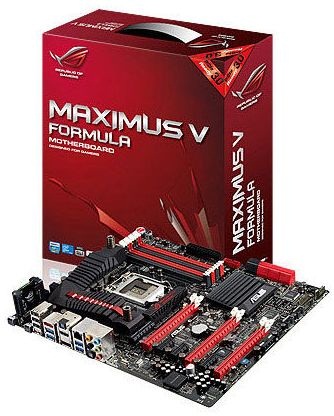ASUS Maximus V Formula Z77 ROG Review
by Ian Cutress on March 25, 2013 2:30 PM EST- Posted in
- Motherboards
- Asus
- ROG
- Z77
Final Words
When I published my review of the ASRock Z77 OC Formula, I praised it as the best board ASRock have ever made. I gave it a Silver Award due to its ease of use, the styling, the level of equipment, and the price which left me feeling all warm and fuzzy inside. Within days of the review being published, ASUS gave me a call. At this time, they were the only manufacturer out of the top four that had not committed any motherboard to my Z77 OC motherboard roundup (Z77 OC Formula, Z77 MPower, Z77X-UP7). So when I gave the ASRock Z77 OC Formula a Silver Award, they quickly wanted to point out just how good the Maximus V Formula was in comparison, and got around to sending me one for review.
As part of this review, ASUS was also keen for me to experience the features of the Maximus V Formula. Our good friend Rajinder Gill, now an audio engineer with ASUS, visited me with several sets of headphones from £70 to £1000 to experience the SupremeFX IV audio system on the Formula, as well as discuss the features on the range. Being no stranger to motherboard flaws and design, Rajinder and I talked at length about the pros and cons of the motherboard industry, motherboard audio, feeling, options, settings, BIOS versions, and how a review should be felt and written, not just a bunch of synthetic tests with a score and a [insert random award] type scenario. For reference on the audio (I cite my comment in the review about the fact that I will always admit to being tone deaf and singing karaoke like a deaf horse with a throat infection), using the high quality headphones with SupremeFX IV and the headphone amplifier makes a distinct difference to the richness of the audio. I rather unsurprisingly felt the biggest difference using a $2 set of headphones in the front audio connectors of the MVF vs. a regular ALC898.
As for the MVF as a package, we have a lot of good points to consider. The MVF is a well built product that performs well but also overclocked like a beast on our setup, both for processor and memory. It hits the high notes in the benchmarks for both performance and efficiency. In the package we get built in WiFi, an Intel NIC, a total of 10 SATA ports, a combination air/water VRM cooler for enthusiasts, the best ALC898-based audio package on a motherboard to date, and not to forget all the fan headers.
The BIOS and software package from ASUS has always been one of the best in our current generation of products, and the ROG feel puts an extra gloss on everything that you use. Extreme overclockers will find the multitude of options that they want here, as well as cooling enthusiasts that must have control over all their fans (and software that actually understands how fans work!).

There are some areas ASUS can improve on where the competition are perhaps getting a minor but noticeable lead. ASRock may not have an EZ mode BIOS, but the Z77 OC Formula offers more automatic overclock options, as well as a better experience due to the enhanced visuals. ASRock also include some plastic standoffs in the package for overclockers to quickly set up a motherboard rather than resting it on a box. Gigabyte has Gigabyte TweakLauncher, a simple GUI overclocking tool for every setting that can be changed in an instant. Both ASRock and Gigabyte have two BIOSes on board in case something goes wrong, and ASRock + MSI have easier to use voltage read points. I also prefer MSI’s method of more VGA power via a 6-pin PCIe connector rather than the 4-pin molex. Gigabyte also includes the OC Touch buttons, which are great for those extra few MHz.
Price wise, the MVF is $290 with AC3 with the package, but has been $270-$300 without in the past eight weeks. Compared to the ASRock Z77 OC Formula ($240, $225 on promo), MSI Z77 MPower ($210, $190 on promo) and the Gigabyte Z77X-UP7 ($400), the Maximus V Formula from ASUS does come along as the most expensive Z77 motherboard without a PLX 8747 chip.
The main competition is from the ASRock Z77 OC Formula of course, which can be $30-$75 cheaper depending on the sales. The ASUS does offer that little bit more – audio, performance at stock/efficiency, software, memory overclocking. The ASUS is definitely more the gamers’ motherboard than the ASRock, which was built more for overclocking - as such the ASRock gives easier voltage read points, more automatic OC options and two BIOSes. As a gamer, I would choose the ASUS due to the software package and the audio capabilities. As a casual competitive overclocker, it is a tough call – I personally had an easier experience with the ASRock, and it would be cheaper to replace if I thrashed and broke it, but I achieved more with the ASUS when pushing the limit. If I am going after scores where I need to be on that limit, the ASUS is the weapon of choice.
The ROG brand from ASUS always produces motherboards worth having. Giving the Formula the SupremeFX IV over the Gene and Extreme puts it into a SKU class of its own which it needed. On the basis of previous reviews, it is hard not to give the Maximus V Formula from ASUS anything but a Silver Award:

ASUS Maximus V Formula
Editor’s Choice Silver Award
The ASUS Maximus V Formula competes in a tough arena with rivals armed to the teeth, and comes out the other side with everything intact ready to fight another day. The competition doesn’t get tougher than this.










38 Comments
View All Comments
DanNeely - Monday, March 25, 2013 - link
Are the 3/8" barbs on the waterblock fixed; or can they be unscrewed and replaced with 1/2" ones?noeldillabough - Monday, March 25, 2013 - link
I'm actually interested in this question too; can we unscrew them and put in G1/4" fittings?DarkStryke - Monday, March 25, 2013 - link
The're fixed, sadly.Razorbak86 - Monday, March 25, 2013 - link
I have an MVF board with two rads and 3/8"x5/8" tubing throughout in a mid-tower case (Corsair Obsidian 650D). The 3/8" tubing was easy to route, looks stunning in blood red color, and performs exceptionally well in my system.Although it would have been nice to have G1/4" connections instead of barbs, once the tubing is installed, the barbs are barely noticeable, because they are hidden after installation of the tubing. Furthermore, there is very little real-world performance difference (from a thermal efficiency perspective) between 3/8" and 1/2" lines in a water cooling setup. Fractions of a degree, actually. Even with G1/4" connections, I would have still chosen 3/8" tubing throughout my system, simply for the ease of routing in my mid-tower case.
DanNeely - Tuesday, March 26, 2013 - link
Yeah. I bought in for 3/8" 5/8" tubing for ease of routing; but lots of people either decided bigger was better or that the last 0.1C was worth chasing and mixed size tubing looks ugly.noeldillabough - Tuesday, March 26, 2013 - link
I agree the smaller tubing is so very close but I got the larger tubing because it looks badass.EnzoFX - Monday, March 25, 2013 - link
I hate how we've devolved in the number of USB Ports. Moreso when there's wasted I/O space. Let alone when it's filled with legacy connections.DanNeely - Monday, March 25, 2013 - link
What exactly on this one are you blaming as a legacy connector? Unless you're complaining that most PC audio is still done via discrete analog hookups instead of via digital connections, or by turning our monitors into TVs I'm not sure what you're complaining about. If that is what you're complaining about, requiring everyone to either buy a tv receiver to break the audio out of their HDMI or to convince monitor makers (that won't spend an extra dollar for a DP input) to add 5.1 audio out to their monitors is delusional.Until Intel/Amd either put a lot more USB3 into their chipsets or add several extra PCIe lanes to the south bridge mixed USB2/3 is going to be here to stay because you can't get 10 or 12 USB3 ports in without giving something else up?
EnzoFX - Wednesday, March 27, 2013 - link
Did I say this particular board had legacy connections? No. My gripe is with few usb ports, a simple to grasp concept. You're average intel board has 6-8 usb ports, this was when Sandy Bridge came along I believe, and then we had DVI/VGA ports on there too, when there's already HDMI on board, or when an adapter could be used. With P55 we had 10USB ports on your most common average/budget board, and that's just on the back. This oh so premium board only has 8.Moricon - Wednesday, March 27, 2013 - link
The bard has 14 USB Ports 2/3, who needs 14 on the back, I want as many coming to the front as possible.